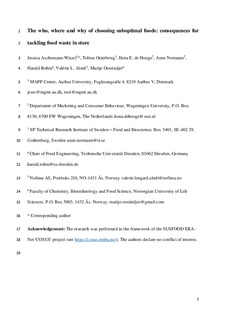| dc.contributor.author | Aschemann-Witzel, Jessica | |
| dc.contributor.author | Otterbring, Tobias | |
| dc.contributor.author | de Hooge, Ilona E. | |
| dc.contributor.author | Normann, Anne | |
| dc.contributor.author | Rohm, Harald | |
| dc.contributor.author | Almli, Valerie Lengard | |
| dc.contributor.author | Oostindjer, Marije | |
| dc.date.accessioned | 2019-10-09T09:13:53Z | |
| dc.date.available | 2019-10-09T09:13:53Z | |
| dc.date.created | 2019-09-05T13:52:18Z | |
| dc.date.issued | 2019 | |
| dc.identifier.citation | Journal of Cleaner Production. 2019, 236 (117596), 1-10. | nb_NO |
| dc.identifier.issn | 0959-6526 | |
| dc.identifier.uri | http://hdl.handle.net/11250/2621102 | |
| dc.description.abstract | Food stores have begun to tackle food waste at the point of sale. They do so by selling ‘suboptimal’ food before it is wasted, typically with a price reduction. However, efficiency of this food waste avoidance action can be improved by knowing for which product category, which store type, which accompanying communication, and which consumer characteristics this action works best. This study uses an experimental online survey conducted in five North western European countries to investigate the effect of communication appealing to either self- or others-centred motives in either supermarkets or farmers' markets, for packaged and for fresh food. It is found that both messages – communicating budget saving or an emotional appeal - are effective in increasing choice likelihood. Store type affects choice likelihood of suboptimal packaged, while others-centred values and trust in the store affects choice likelihood for suboptimal fresh food. Communication improves quality perception of suboptimal fresh food. Findings imply that fresh suboptimal foods lend themselves more to be promoted with others-centred messages, or to be targeted at consumers with others-centred values. Sales of suboptimal food in the store should be accompanied by communication, and such efforts to tackle food waste in the store should focus on fresh food in particular. | |
| dc.language.iso | eng | nb_NO |
| dc.title | The who, where and why of choosing suboptimal foods: Consequences for tackling food waste in store | nb_NO |
| dc.type | Journal article | nb_NO |
| dc.type | Peer reviewed | nb_NO |
| dc.description.version | submittedVersion | |
| dc.source.pagenumber | 1-10 | nb_NO |
| dc.source.volume | 236 | nb_NO |
| dc.source.journal | Journal of Cleaner Production | nb_NO |
| dc.source.issue | 117596 | nb_NO |
| dc.identifier.doi | 10.1016/j.jclepro.2019.07.071 | |
| dc.identifier.cristin | 1721920 | |
| dc.relation.project | Norges forskningsråd: 262308 | nb_NO |
| dc.relation.project | Nofima AS: 201702 | nb_NO |
| cristin.unitcode | 7543,3,3,0 | |
| cristin.unitname | Sensorikk, forbruker og innovasjon | |
| cristin.ispublished | true | |
| cristin.fulltext | preprint | |
| cristin.qualitycode | 2 | |
